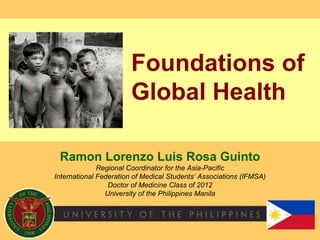
Foundations of Global Health
- 1. Foundations of Global Health Ramon Lorenzo Luis Rosa Guinto Regional Coordinator for the Asia-Pacific International Federation of Medical Students’ Associations (IFMSA) Doctor of Medicine Class of 2012 University of the Philippines Manila
- 3. What does HEALTH mean to us?
- 14. What shapes HEALTH?
- 15. The Determinants Approach Biological Environmental Social
- 23. Tuberculosis TB deaths in England Streptomycin BCG Vaccination * David Werner, Questioning the Solution: The Politics of Primary Health Care and Child Survival, Healthwrights, 1997, p. 76. (cited also in WHO SDH Background papers)
- 25. Source: Ravi Narayan, SOCHARA, India
- 26. How do we measure HEALTH?
- 30. Millennium Development Goals eradicate extreme poverty and hunger achieve universal primary education reduce child mortality improve maternal health combat HIV/AIDS, malaria and other diseases ensure environmental sustainability develop a global partnership for development promote gender equality and empower women
- 32. Health Equity Marmot, 2007
- 33. Life Expectancy at Birth (Men) Marmot, 2007
- 34. Travelling east from Westminster, each tube stop represents up to one year of male life expectancy lost at birth (2002-06) Westminster Waterloo Southwark London Bridge Bermondsey Canada Water Canary Wharf North Greenwich Canning Town London Underground Jubilee Line The Jubilee Line of Health Inequality Electoral wards just a few miles apart geographically have life expectancy spans varying by years. For instance, there are eight stops between Westminster and Canning Town on the Jubilee Line – so as one travels east, each stop, on average, marks up a year of shortened lifespan. 1 River Thames 1 Source: Analysis by London Health Observatory using Office for National Statistics data revised for 2002-06. Diagram produced by Department of Health Male Life Expectancy 72.8 (CI 71.1-74.6) Female Life Expectancy 81.4 (CI 79.3-83.6) Male Life Expectancy 78.6 (CI 76.0-81.2) Female Life Expectancy 84.6 (CI 82.5-86.7)
- 35. LEB over 80 years IMR less than 10 MM less than 15 LEB under 60 years IMR over 90 MM over 150 Source: Dr. Ramon Paterno, University of the Philippines
- 36. More than 3,000 Filipina mothers die UNNECESSARILY annually MATERNAL MORTALITY RATE Per 100,000 Livebirths; 2002 UNDP Revision Source: Dr. Ramon Paterno, University of the Philippines Country 1985-2002 Philippines 170 Thailand 36 Malaysia 30 South Korea 20 Japan 8 Italy 7 Spain 0
- 37. How can we improve HEALTH?
- 38. The Current Model of Health Preventive Promotive Curative Rehabilitative
- 39. A Proposed New Paradigm of Health Health Justice Health Creation Health Sustainability Health Protection
- 41. 1978: Alma Ata Declaration
- 42. Alma Ata, 1978 The International Conference on Primary Health Care calls for urgent action by all governments, all health and development workers, and the world community to protect and promote the health of all the people of the world by the year 2000.
- 44. Primary Health Care Principles Community participation Multidisciplinary Health promotion and disease prevention Appropriate technology Equity Social understanding of health Global cooperation and peace Call for a New International Economic Order
- 49. Action on Social Determinants
- 51. What is GLOBAL HEALTH?
- 52. Evolution of Global Health International Health Public Health Global Health Tropical Medicine
- 58. Brief History of Global Health http://www.dipity.com/GHhub/Global-Health-Care/
- 61. Six Minds for our Global Health Future “ Futures” Thinking Mind Systems Thinking Mind “ Determinants” Mind Rights-Based Mind People-Centered Mind Evidence-Based Mind
- 62. Global health means taking care of people you don’t know and people you can’t see but who you know were there and were special, just like you and me. From an MPH student
- 63. “ The doctor of the future will give no medicine, but will interest his patients in the care of the human frame, in diet, and in the cause and prevention of disease.” Thomas Alva Edison
- 64. “ The principle upon which the fight against disease should be based is the creation of a robust body; but not the creation of a robust body by the artistic work of a doctor upon a weak organism; rather, the creation of a robust body with the work of the whole collectivity, upon the entire social collectivity.” Che Guevara “ On Revolutionary Medicine”
- 65. The Power of Medicine "Medicine is a social science, and politics is nothing else but medicine on a large scale. Medicine, as a social science, as the science of human beings, has the obligation to point out problems and to attempt their theoretical solution ; the politician, the practical anthropologist, must find the means for their actual solution....The physicians are the natural attorneys of the poor , and social problems fall to a large extent within their jurisdiction.” Dr. Rudolf Virchow Father of Social Medicine
- 66. The Power of Young People “ The youth are the hope of the Fatherland.” Dr. Jose Rizal National Hero of the Philippines
- 67. Fathers of Social Medicine
- 68. Thank You Very Much! Health for All! Alma Ata, USSR, 1978 Almaty, Kazakhstan, 2008
Hinweis der Redaktion
- Greet… Introduce oneself…
- ok
